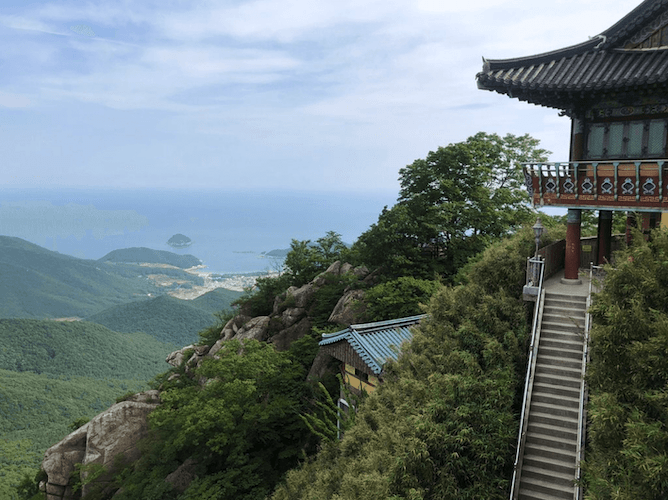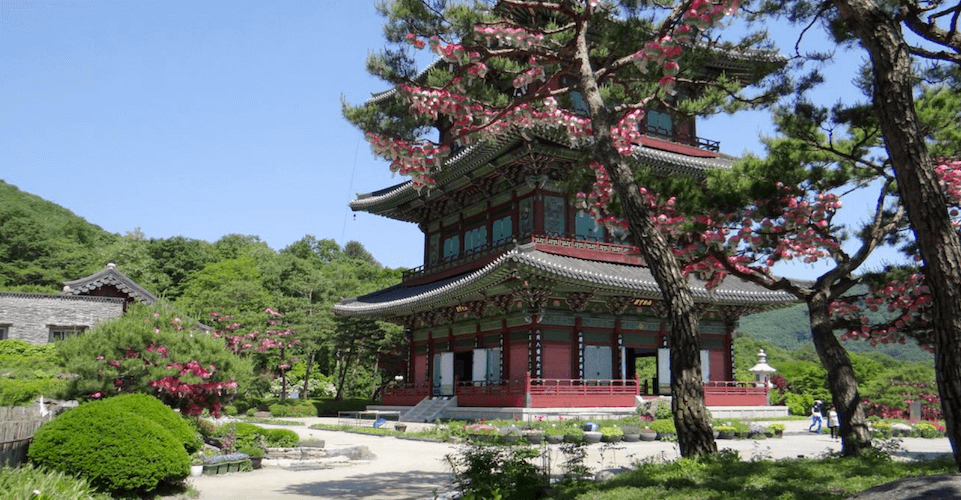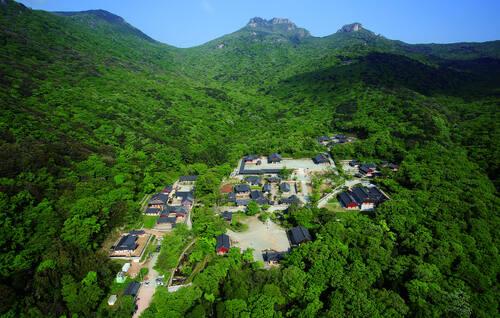Last Updated on 5 years by admin
All of Korea’s 900-plus traditional Buddhist temples are culturally important, and they are historically significant, 33 of them are exceptionally beautiful. Did you know there are around 20,000 temples in South Korea? A visit to any of these places can be humbling, calming, and can offer a peaceful experience.
Many of the Korean Buddhist temples are found nestled in the different mountains of South Korea. Most of these locations are believed to have the best feng shui (pung-su) of the area.
All the temples in Korea are endlessly beautiful, majestic, and simply breathtaking! Out of all the 900 Buddhist temples in the country, you can visit the 33 temples below. CNN Travel editors chose the number 33 to match Buddha’s 22 steps to enlightenment.
Taeansa Temple (태안사)
Taeansa Temple was located on the foot of Dongrisan Mountain and was built by three monks during the Silla period. It was significantly damaged during the Korean wars and has been refurbished then. The Korean temple is a quite a popular trail during the fall with its bright maple leaves, invigorating valley, and a shady nook.

Address: 622-215 Taean-ro, Jukgok-myeon, Goksung-gun, Jeollanam-do
Manggyeongsa Temple (망경사)
Manggyeongsa Temple is situated on Taebaek mountain, at an altitude of 1,460 meters. According to a legend, a stone statue of the Bodhisattva of wisdom appeared at the Manggyeongsa Temple site. And when a monk from the Silla Dynasty heard of it, he built the Korean temple to enshrine the statue.

Address: Hyeol-dong, Taebaek-si, Gangwon-do
Naejangsa Temple (내장사)
Naejangsa Temple is located amid the beautiful Naejangsan National Park and was built by the Buddhist monk Yeongeunjosa in the year 636 of the Baekje dynasty. Like many other Korean temples, it was destroyed during the Korean wars and was later reconstructed in the 1970s. The scenic beauty around the Temple is definitely a sight to behold in the fall.

Address: 1253 Naejangsan-ro, Jeongeup-si, Jeollabuk-do
Daejeonsa Temple (대전사)
Great Monk Uisang built Daejeonsa Temple in 672 AD. The Korean temple is situated on the foothill of Juwang Mountain, giving magnificent views of its peaks.

Address: 226 Gongwon-gil, Budong-myeon, Cheongsong-gun, Gyeongsangbuk-do
Cheongpyeongsa Temple (청평사)
Cheongpyeongsa Temple is situated on the beautiful misty slopes of Obongsan Mountain. The Korean temple was built in the Goryeo dynasty, and vast, beautiful gardens surround it.

Address: 674 Cheongpyeong 1 ri, Buksan-myeon, Chuncheon-si, Gangwon-do
Boeun Beopjusa Temple (법주사)
Beopjusa Temple was built in 553 in the Silla period, and it is located on Songnisan Mountain. Several structures were destroyed during was but were rebuilt in 1624. The Korean temple features several beautiful and important Buddhist relics and artworks centered around the main hall. Beopjusa Temple has the highest pagoda in South Korea; it is a five-story high wooden pagoda.

Address: 405 Beopjusa-ro, Sokrisan-myeon, Boeun-gun, Chungcheongbuk-do
Gangcheonsa Temple (강천사)
Gangcheonsa Temple is located near the entrance of Gangcheonsan County Park and was built in the Silla Period. Over time, more buildings were added, including a five-story stone pagoda.

Address: 270 Gangcheonsan-gil, Paldeok-myeon, Sunchang-gun, Jeollabuk-do
Buseoksa Temple (부석사)
Buseoksa Temple was built in the Silla Era by the Great Monk Uisang in 677 on the Dobisan Mountain is Seosan. From the summit of the mountain, you can get a fantastic view of the Seohae Sea beyond Ganwoldo and Anmyeondo islands, as well as Gayasan Mountain. Buseoksa’s Muryangsujeon is one of Korea’s oldest wooden buildings.

Address: 148 Bukji-ri, Busuk-myeon, Yeongju-si, Gyeongsangbuk-do
Gurye Cheoneunsa Temple (천은사)
Cheoneunsa Temple was built during the Unified Silla Period in the Gurye region, southwest part of Jirisan Mountain. The Korean temple is one of the three magnificent Buddhist temples of Jirisan Mountain. It was first built in 828, burned down during the Japanese Invasion of Korea in 1592, rebuilt in 1610, burned down again in 1676, rebuilt the next year, caught fire once again in 1773, and finally rebuilt in 1775.

Address: 209 Nogodan-ro, Gwangui-myeon, Gurye-gun, Jeollanam-do
Geumsansa Temple (금산사)
Geumsansa Temple was first built in the year 599 and houses several treasures like stone pagodas, stone lantern, and lotus flower-shaped pedestal. There are ten cultural properties, and it has the country’s only three-story building containing a Buddha statue. The statue is the largest indoor standing Buddha in the world, reaching 11.82 meters in height.

Address: Geumsan-ri, Geumsan-myeon, Gimje-si, Jeollabuk-do
Golgulsa Temple (골굴사)
Golgulsa Temple houses 12 limestone caves in a tall cliff with a rock-carved statue of Buddha at the highest point. Some caves are small with space for a single person, while others are spacious enough for three to four people. The Korean temple is located at the foot of the limestone cliff of Hamwolsan Mountain in Korea. Golgulsa Temple also offers training programs and temple stay programs.

Address: 304-1 San Andong-ri, Yangbuk-myeon, Gyeongju-si, Gyeongsangbuk-do
Sasungam Temple (사성암)
The Temple is lodged in between the large rocks. It’s a small temple that features a beautiful and steep stone staircase adorned with tiles. You can hike to the Korean temple for some beautiful sights of Seonjingang River and Jiri Mountain.

Address: 303 Saseongamgil, Muncheok-myeon, Gurye-gun, Jeollanam-do
Hyangiram Hermitage (Hyangilam Temple) (향일암)
Hyangiram Hermitage is one of four Buddhist hermitages in Korea where the faithful come to pray. The temple entrance has a 500-year old camellia tree. The mountain path to Hyangiram Hermitage is very steep, and it is one of the exciting mountain courses in Korea. Hyangilam’s view of the southern coast and Geumo mountain makes it one of the best places to visit in South Korea.

Address: 60 Hyangilam-ro, Dolsan-eup, Yeosu-si, Jeollanam-do
Magoksa Temple (마곡사)
Magoksa Temple is surrounded by a mountain and a stream curving in the yin-yang shape. The Korean temple is lovely during the springtime with all the cherry blossoms and magnolias. The Five-story Stone Pagoda and the Chinese juniper trees are the two eye-catching sights in around the Temple.

Address: 966 Magoksa-ro, Sagok-myeon, Gongju-si, Chungcheongnam-do
Samwhasa Temple (삼화사)
Samhwasa Temple is located near the entrance of the Mureung Valley of Dutasan Mountain in the City of Donghae. It’s a small temple but a thousand-year-old built during the Silla Kingdom. Samwhasa Temple operates a school teaching Buddhism and offers temple stay programs providing a serene experience of temple life.

Address: 176 Samhwa-dong, Donghae-si, Gangwon-do
Yeongcheon Baekheungam Temple (백흥암)
It’s a small temple that is home to Buddhist nuns and is not open to the public except on Buddha’s birthday. Especially on occasion, you can take a picture with the beautiful magnolia trees out the front.

Address: Chiin-ri, Cheongtong-myeon, Youngchun-si, Gyeongsangbuk-do
Tongdosa Temple (통도사)
The Temple is located in the southern part of Chiseosan Mountain and was built during the Silla dynasty. Tongdosa Temple is famous for not having any Buddhist statues in the Korean temple. The temple’s name ‘tongdo‘ means ‘passage,’ and was named to symbolize the Temple as the passage to enlightenment. The passage also refers to the Geumgang Stairs, as one who wishes to be a monk must climb these steps.

Address: 108 Tongdosa-ro, Habuk-myeon, Yangsan-si, Gyeongsangnam-do
Damyang Boriam Temple (보리암)
Boriam Temple is located on a cliff in Chuwolsan, and the mountain is famous for its remarkable landscape. You can see strange-looking rock formations, rugged precipices, glimpses of roof tiles of the buildings, and an expansive view of Damyang Lake from the Korean temple.

Address: 81 San Wolgye-ri, Yong-myeon, Damyang-gun, Jeollanam-do
Suncheon Songgwangsa Temple (송광사)
Songgwangsa Temple is located on the west side of Jogyesan Mountain and is a famous sambosachal in Korea. Sambo means ‘three treasures’ in Korean, and in Buddhism, there is bulbo, beopbo, and seungbo. Beautiful tall trees cover the road to the Temple. It is one of the three jewel temples of Korea. A creek from Jogye Mountain has been utilized to create an artificial pond near the temple entrance.

Address: 100 Songgwangsaangil, Songgwang-myeon, Suncheon-si, Jeollanam-do
Pohang Oeosa Temple (오어사)
Oeosa Temple boasts a scenic beauty of Oeo Lake and rock cliffs. It was built during the reign of King Jinpyeong of the Silla Dynasty. There is an interesting story behind the name of the Temple, where two monks competed for reviving a pair of fish with their Buddhist power. One fish lived, and the other died, and both monks argued that the living fish was the one which he revived.

Address: Hangsa-ri, Ocheon-eup, Nam-gu, Pohang-si, Gyeongsangbuk-do
Bonghwa Cheongnyangsa Temple (청량사)
The Cheongnyangsan Temple is located in the Cheongnyangsan Mountain Provincial Park by the great monk Wonhyo in 663 (Silla Kingdom). The Temple is ideally placed according to feng shui with 12 mountain peaks that surround the Temple, like the petals of a lotus flower. While visiting the Korean temple, you should also check out the eight caves around the Temple.

199-152 Cheongryangsan-gil, Myeongho-myeon, Bonghwa-gun, Gyeongsangbuk-do
Suncheon Seonamsa Temple (선암사)
Seonamsa is famous as it is the birthplace of novelist Jo Jung-rae. Seonamsa Temple is described as a ‘lonely and silent temple of asceticism in a poem by Koryo scholar Kim Geuk-gi. The Temple is also known for the wild tea that grows nearby. The tea from the region has an earthy and deep flavor.

802 Jukhak-ri, Seungju-eup, Suncheon-si, Jeollanam-do
Jincheon Botapsa Temple (보탑사)
Botapsa Temple is relatively less historically rich as compared to the other thousand years old temples in the list. But, even then, it is equally majestic with its three stories wooden pagoda that’s mountable. It is one of its kind in South Korea. Botapsa Temple also offers three different temple stay programs.

Address: 641 Gimyusingil, Jincheon-eup, Jincheon-gun, Chungcheongbuk-do
Hwaeomsa Temple (화엄사)
It’s an ancient temple that was completed in two centuries – from 544 to 875! Hwaeomsa Temple is situated in the southwest corner of Jirisan Mountain. The path to the Korean temple lies along the valley named Hwaeomsa Temple Valley. It also takes you to Nogodan Plateau of Jirisan Mountain. Cherry blossoms are planted alongside Route 19 – from Hadong to the Temple – offering drivers a fantastic view every spring.

Address: 539 Hwaeomsa-ro, Masan-myeon, Gurye-gun, Jeollanam-do
Maisan Tapsa Temple (탑사)
Tapsa Temple is famous for the over 80 stone pagodas built by Lee Gapyong, a retired scholar. These stone pagodas have different sizes and shapes, ranging from cone-shape to straight-shape. Some of the 80 stone-stacked towers are more than 15 meters high, and they have survived typhoons in the region for years. The Temple is also quite famous for cherry blossoms in spring covering a 30 min walk with gorgeous flowers. The road from Nambu parking lot of Maisan Mountain to the temple entrance is the venue for the Maisan Cherry Blossom Festival.

Address: Maisan Tapsa, 8 Dongchon-ri, Maryeong-myeon, Jinan-gun, Jeollabuk-do
Unjusa Temple (운주사)
Unjusa Temple is famous for its many stone Buddhas and stone pagodas. Right now, there are only 17 pagodas and 80 stone Buddhas when there were 1000 housed at one point. The stone figurines and pagodas are of different shapes and sizes. It was called Bibosa Temple during the late Silla Period.

Address: 91-44 Cheontae-ro, Doam-myeon, Hwasun-gun, Jeollanamdo
Haenam Daeheungsa Temple (대흥사)
Splendidly dense forests, fields of silver grass, and a view of the archipelago of the western and southern coast of South Korea are picturesque when you visit the Daeheungsa Temple. According to most historians, the Korean temple was built before the unified Silla period.

Address: 799 Guryum-ri, Samsan-myeon, Haenam-gun, Jeollanam-do
Ssangbongsa Temple (쌍봉사)
Ssangbongsa literally means a pair of peaks, and so the Temple named after it. The temple lies between two mountain peaks – one in the front and one behind. The temple was first constructed in 868 but was burnt down, and it has been reconstructed since then.

Address: 459 Ssangsanui-ro, Iyang-myeon, Hwasun-gun, Jeollanam-do
Beomeosa Temple (범어사)
Beomeosa Temple is located on the eastern edge of Geumjeongsan Mountain in Busan in 678 by Uisang Daisa during the Silla dynasty. It is one of the three largest temples in the Gyeongsang province. Most of the original temple site was lost during the Japanese Invasion and 1592 but was reconstructed in 1613. Beomeosa Temple also operates a temple stay program for visitors to learn more about Buddhist culture and discover oneself. There are many attractions in the region, including a national monument.

Address: 250 Beomeosa-ro, Geumjeong-gu, Busan
Yeongoksa Temple (연곡사)
Yeongoksa Temple was constructed by Yeongi, a high Buddhist monk, who also helped create Hwaeomsa Temple. Although it was destroyed during Korean conflicts, and despite the damage, the Temple still looks beautiful and peaceful. The name Yeongok refers to the phenomenon of ‘Yeon,’ a swallow, and ‘Gok,’ a valley. The Temple also offers an option of temple stay, where you can stay at the Korean temple for a peaceful retreat.

Address: 219 Naedong-ri, Toji-myeon, Gurye-gun, Jeollanam-do
Dobong Cheonchuksa Temple (천축사)
Cheonchuksa Temple sits on the Dobongsan Mountain along with many other temples, including Mangwolsa and Hoeryongsa. It has been renovated several times in the last few centuries. The Temple gets its name from Jigong, an Indian monk who visited the site in the Koryo dynasty. He said that the scenery was similar to that of a mountain in Cheonchuk, which meant ‘India.’ There are many hiking trails on the mountain which you can access.

Address: 92-2 Dobongsangil, Dobong-gu, Seoul
Sujongsa Temple (수종사)
It’s a place that’s not only appreciated by the believers of the religion but tourists as well who enjoy hiking. Sujongsa Temple is located at the top of Ungil mountain (610 meters), and the Sujongsa means ‘water bell temple.’ It offers visitors a magnificent view of high and low mountain peaks and the Bukhan River. It is unclear when this Temple was erected, but it is estimated to have been built in the early Joseon Dynasty (1392-1910).

Address: 1060 Songchon 1-ri, Joan-myeon, Namyangjoo-si, Gyeonggi-do
Bulyoungsa Temple (불영사)
The Temple’s name, Bulyoungsa, means ‘the reflection of Buddha’s shadow on the pond.’ The majestic Bulyoungsa Temple temple stands amidst the Bulyoungsa Valley creating almost a mystical atmosphere. The Temple is located at the western foot of Mt. Cheonchuksan in Uljin and was built during the Silla period. You can get an extraordinary view of luxurious thick forest, unique rock formations, and crystal clear water.

Address: 48 Bulyoungsagil, Seo-myeon, Uljin-gun, Gyeongsangbuk-do
23,324 total views, 3 views today

















